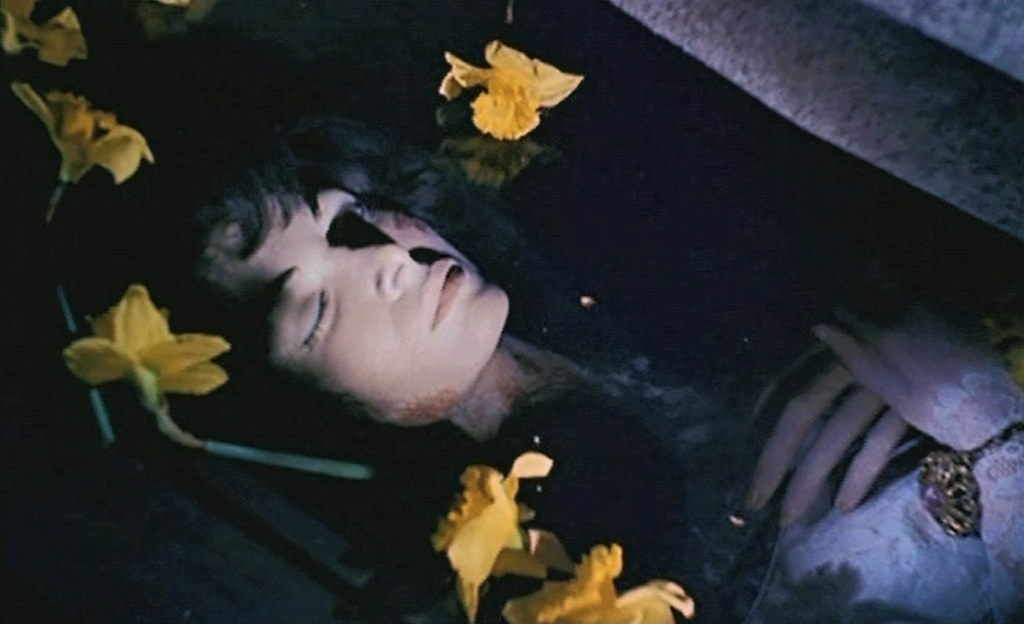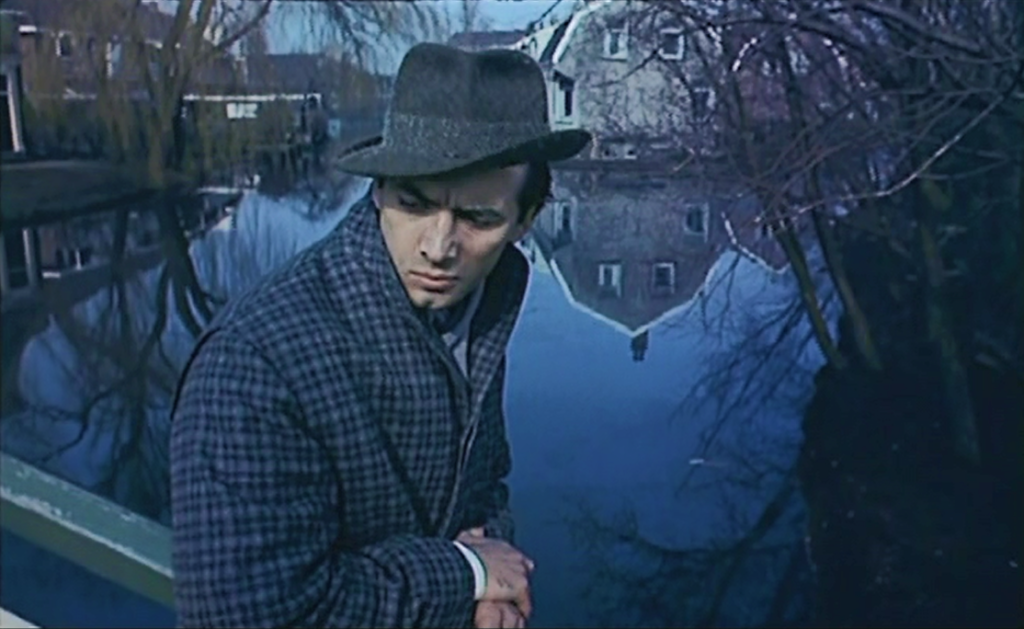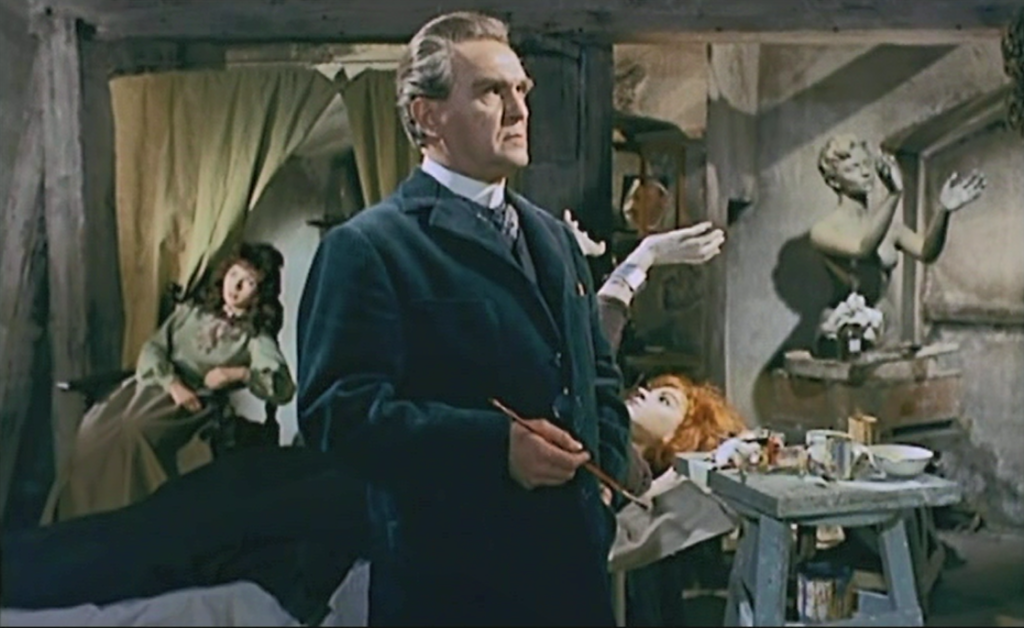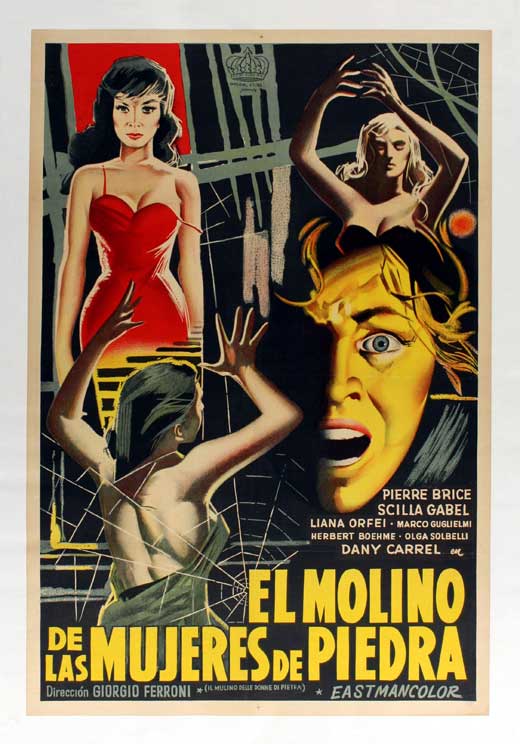
It’s difficult to imagine a more ingeniously original Gothic tableau than the one conjured by the Italian horror Mill of the Stone Women (Il mulino delle donne di pietra, 1960). Here we get not a haunted estate or castle, but a windmill perched on a canal beneath overcast skies, its gloomy interior featuring, among other surprises, a sculptor’s studio with disembodied limbs hung on the walls, a plushly furnished bedroom at the end of a cobweb-laced corridor, and a macabre carousel of statues – of the Chamber of Horrors variety – the operation of which is triggered by the movement of the windmill blades. The latter feature is a town tourist attraction, which does not seem so unusual to me, because I live about forty-five minutes from Wisconsin’s perennially popular but somewhat unnerving House on the Rock. To this mill in the Netherlands comes Rotterdam journalist Hans von Arnim (Pierre Brice, later the star of Germany’s long-running “Winnetou” series of Westerns), who’s writing a story on the clockwork display, now presided over by art professor Gregorius Wahl (Herbert Boehme, Secret of the Red Orchid), whose great-grandfather first built it 100 years ago. Wahl is a sculptor himself, and his studio features not just the aforementioned random limbs but also a topless woman with a noose around her neck, with which director Giorgio Ferroni (Night of the Devils) lovingly fills the frame. Wahl is reluctant to have Hans intruding upon his odd domestic life, which consists of just him, a housekeeper (who must be charged with keeping the cobwebs free of dust), and his mysterious daughter Elfie (Scilla Gabel, Arms of the Avenger). The vampiric Elfie makes a striking entrance: after a small dog hops out from curtains that divide the foyer with a room where Hans has heard drifting piano music, two hands emerge, grasping the drapes and framing a small pale face. It will be some time before Hans can actually meet her, initiating a passionate and brief affair that triggers the tragic events and increasingly strange revelations that follow.

Pierre Brice as Hans von Arnim.
Brice is an impulsive and selfish protagonist, bedding and then discarding Elfie while caring for his ongoing relationship with the beautiful Liselotte (half-Vietnamese actress Dany Carrel, of the same year’s Hands of Orlac). The rejection culminates in Elfie’s death, for she suffers from the same fragile condition as her late mother. This leads Brice into a guilt-ridden spiral, and Ferroni impressively cuts loose the viewer’s moorings, seamlessly moving into a drug-induced dream sequence not unlike those in Roger Corman’s Poe adaptations (just getting underway with The Fall of the House of Usher), right as the viewer, like the protagonist, begins to questions what is and isn’t real. Notably, the film begins and ends with the summoning of a ferryman, providing a mythological theme and possibly an actual shade in her thin-blooded character who, we soon learn, is ever dancing back and forth across the boundary of life and death. The windmill’s decorations and its sinister-carnival version of It’s a Small World remove any doubt that we might be in Hell, though the location reveals one additional circle in its final act: the bloody laboratory of a mad scientist (Wolfgang Preiss, The 1,000 Eyes of Dr. Mabuse).

Herbert A.E. Böhme as professor and sculptor Gregorius Wahl.
This final jarring reveal suggests a hodgepodge of horror elements thrown together, but Mill of the Stone Women feels much more unified than that; it’s as elegant as it is playfully self-referential. Though not shying from black humor, Ferroni keeps the tone away from camp by maintaining a somber, funerary atmosphere, echoed the same year in Corman’s Usher and Mario Bava’s Black Sunday (La maschera del demonio). And although petrification is the tool used to make the too-human statues, by association Ferroni’s film also contributes to the waxworks subgenre – whose most famous entries are Mystery of the Wax Museum (1933) and House of Wax (1953) – with some genuinely creepy manipulations of mannequins and corpses to join the gruesome merry-go-round. Such films offer a lite metatextual element, inviting the viewers to compare themselves with spectators attending a house of horrors and admiring the displays. Here we first stand beside the townsfolk who’ve ferried up to the windmill to watch a daisy chain of poisoners and stranglers rotating to a cheery melody; and soon enough Ferroni continues the spectacle with a real mad scientist, the living dead, and even a bit of peek-a-boo nudity. Naturally, as must happen in any horror film featuring a windmill (from Frankenstein onward), the structure is ultimately set ablaze, which gives us the opportunity to watch the flames expose the skulls hidden beneath the statues’ masks. It all comes together with gloomy grace.










